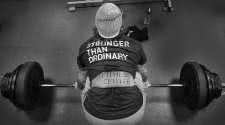How to Change your Weight Training Routine every 3 to 4 Weeks

Exercise & Fitness Research for Results
You work it as hard as, if not harder than, your other bodyparts, but it just won't budge. It gets sore after almost every session it had better; you show it no mercy but there's no new growth to speak of. To make matters worse, it taunts you every time you check the mirror.
You know it as the dreaded lagging bodypart, the slacker of your physique. We all have them, and there are any number of reasons why they refuse to grow from poor neuro-efficiency to bad leverage to short attachments. No matter what the reason, however, a sound training strategy
can shake these laggards out of their slumber, and you don't have to train in a huge commercial gym with numerous pieces of exotic equipment to do it.
A basic home gym is all you need, as you'll see next month when I outline specific routines. Before I get to those specifics, though, allow me to covet a few generalities, namely, common mistakes bodybuilders make when it comes to bringing up a lagging bodypart.
1. Getting set happy. As I've said in the past, volume is a form of overload, but too much is the primary source of overtraining. What is 'too much"? It's whatever puts you over the edge. While everyone's recovery capacity differs, most bodybuilders get into trouble when set
totals for any one bodypart exceed the six-to-eight range twice a week, not including warmup sets. I'm talking six to eight heavy work sets here, and when your work-set totals for any one bodypart start hitting double digits, better introduce some extra recovery days pronto.
For example, if you're on a standard Monday-Tuesday-Thursday-Friday split and for some reason-say, your quarts did some unusually cruel taunting when you checked them in the mirror-you decide to blast quads with 12 hard, heavy sets on Monday until you can barely walk, you may want
to skip quad work on Thursday altogether and wait until the following Monday to hit them again. Yes, it often takes seven days for a muscle to fully recover when it receives a workload shock of this magnitude.
2. Training with too much intensity. Nowadays most people equate intensity with more muscle growth, and that's good. Harder training is the answer in a lot of cases. The problem occurs when every workout becomes an intensity tactic every set blitzkrieg. Even Mike Mentzer, Mr.
Heavy Duty himself, found that forced and negatives reps were counterproductive when he used them at every workout and even every other work maybe too much for most bodybuilders, Pushing until you can't do another rep in good form is optimal intensity most of the time. If, on the
other hand, you're attn your lagging bodypart with drop sets, forced reps rest/pause and/or max negatives at every session, it's no wonder it refuses to grow. It's on strike.
3. Throwing heavy weights around. Yes, there is some correlation between strength and size, but that doesn't mean you have to pile on the poundage until you're contorting every joint in your body just to lockout with it. Be patient. Feeling the muscle contract is much more important
on most exercises than moving heavy metal. In Positions-of-Flexion protocol I recommend that you focus on driving up heavy poundages with good form during your midrange, or compound, movements, concentrate on twitching out of the bottom of each stretch-position movement with
medium-heavy poundages and use a one-to-two-second squeeze on the contracted-position exercise, which also requires medium-heavy poundages. The only place you really focus on heavy poundage is with the midrange exercise, and even so, form is the most important factor, not the
poundage-although you should try to add a couple of 2 1/2s or fives every so often in order to reap the benefits of progressive overload. lust don't start heaving to get it done. Throwing around weights that are too heavy for you does nothing but prime your joints for injury,
so don't think you're going to bring up a lagging bodypart by suddenly piling on the plates.
4. Overtaxing your system. Your body can only stand so much work. If you're already pushing it full- throttle and then you add sets to your lagging bodypart exercises, what's going to happen? Say hello to Mr. Overtraining. who can quickly turn into Captain Catabolic. As I mentioned
above, everyone's capacity for work is different, but it safe to say that most bodybuilders should remain in the 25-total-work- sets range for any one workout, That means if you're at 25 now and you're going to add a few sets for a lagging bodypart, you'd better cut a set or two
from a few of your stronger muscle groups.
Think about these four mistakes, and try not to make them if you're currently specializing on a body-part.